Social tenants in Scotland 2017
Overview of social tenants and social rented housing in Scotland for 2017, covering information on stock, households, housing flows, rents and income.
This document is part of a collection
Section 5 - Housing Costs and Income
5.1 Average rent levels in social housing - Scotland
Data from the Scottish Housing Regulator, as published in their Charter Indicators and Data by Outcomes and Standards[29], shows that the average rent for a social sector property in Scotland in 2017/18 was £76.23, with housing association properties averaging £82.28 per week, 16% higher than the average rent of £70.73 for a local authority property.
Average housing association rents were higher than local authority rents for each property size category in 2017/18, with average housing association rents ranging from £71.43 per week for a 1 apartment property to £98.47 per week for a 5 apartment property. Local authority average weekly rents ranged from £59.21 for a 1 apartment property to £81.99 for a 5 apartment property.
Note that apartment size categories are based on a count of the number of bedrooms and living/dining rooms. Kitchens, bathrooms, toilets and utility rooms are not included.
Chart 5.1: Average weekly rents, 2017/18, by social landlord type and property size
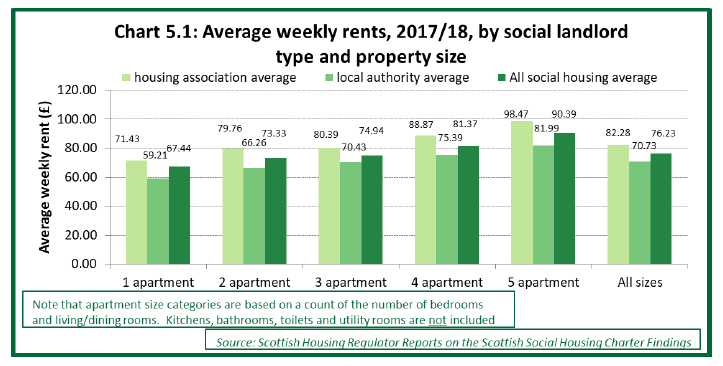
The average rent of £76.23 for a social sector property in Scotland in 2017/18 was an increase of 2.4% on the previous year.
Over the five financial years from 2013/14 to 2017/18, average weekly social sector rents have increased by 4.5% from £67.96 in 2013/14 to £70.99 in 2014/15, after which there was an annual increase of 2.7% to £72.90 in 2015/16, an annual increase of 2.1% increase to £74.44 in 2016/17, and then an annual increase of 2.4% in 2017/18.
This is a cumulative increase of 12.2% between 2013/14 and 2017/18, which equates to a real terms increase of 6.9% (i.e. an increase of 6.9% over and above CPI inflation of 5.3% over these years).
Average social sector rents have increased over each of the last two financial years for each property size category.
It should be noted that behind these Scotland level figures, average rents are likely to vary by provider and across regions of the country, and there may be a range of factors affecting rent levels, including the different range of client groups that each landlord is supporting. Information on average rents by property size for each social landlord is published by the Scottish Housing Regulator as part of the range of financial and performance information collected from social landlords to help monitor performance against the standards and outcomes of the Scottish Social Housing Charter[30].
Chart 5.2: Average weekly rents, 2013/14 to 2017/18, for social rented housing
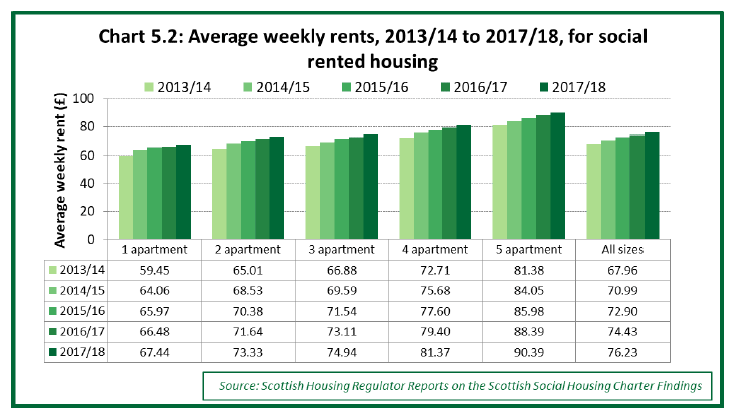
Chart 5.3 below shows a comparison between average social rents in Scotland for a 3 apartment property (i.e. 2 bedrooms plus 1 living room) and average private rents[31] in Scotland for a 2 bedroom property. It can be seen that social rents in Scotland for this size of property have been around half the level of private sector rents for each of the last five years 2013/14 to 2017/18.
Chart 5.3: Average weekly rents Scotland, 2013/14 to 2017/18, by sector (private sector rent years to end September)
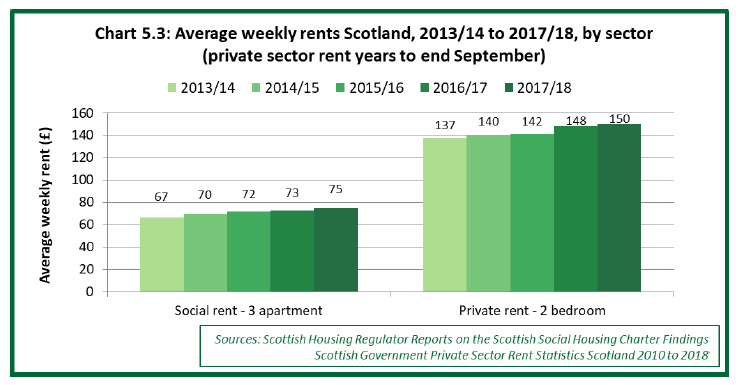
5.1 Average rent levels in social housing - Scotland compared to other UK countries
It is possible to compare average rent levels between Scotland and other UK countries, although comparisons between countries should be seen as indicative rather than highlighting exact differences, due to some differences in the detail of how each set of average rent figures are calculated.
Chart 5.4 illustrates how average housing association rents have varied by UK country across the 2014/15 to 2017/18 period. It can be seen that Northern Ireland and England have had the highest average rents, although Northern Ireland figures for 2016/17 and 2017/18 are not yet available.
Average housing association rents in England have fallen across the latest two years by 1.3% and 1.1% respectively, which is likely to reflect the Summer Budget 2015 announcement that the UK government would reduce rents in social housing in England by 1% a year for 4 years until 2020/21[32].
In Scotland, whilst it is up to individual social landlords to strike the best balance between rent levels and meeting the housing needs of local communities, landlords are required to consult tenants and take account of their views when making decisions about proposed rent increases.
Scotland has seen lower average housing association rents across the 2014/15 to 2017/18 period than all other UK countries, with annual increases over the latest three years being 2.5%, 1.8% and 2.5% respectively. In the latest year 2017/18, average housing association rents in Scotland were around 14% lower than in England, and around 6% lower than in Wales.
Average rents in Wales have been slightly higher than in Scotland in each year since 2014/15, and have been increasing at a faster rate each year, which is likely due to a rent setting policy which includes provisions for increases of CPI+1.5%[33].
Chart 5.4: Average Housing Association weekly rents, 2014/15 to 2017/18, by UK Country
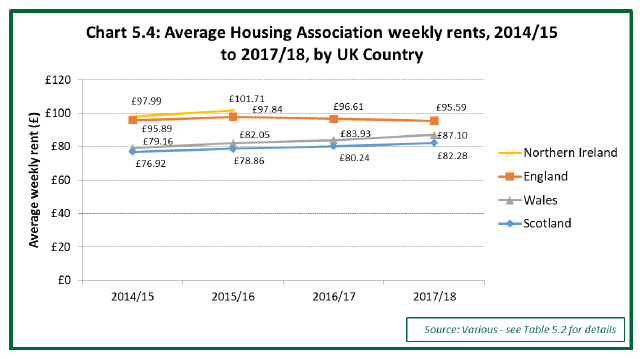
Chart 5.5 below illustrates how average local authority rents have varied by UK country across the 2014/15 to 2017/18 period.
Note that the figures for England are an average of both social rents and affordable rents, although affordable rented units are likely to make up a relatively low proportion of all local authority stock in England in the years up to 2017/18.
Chart 5.5: Average Local Authority weekly rents, 2014/15 to 2017/18, by UK Country
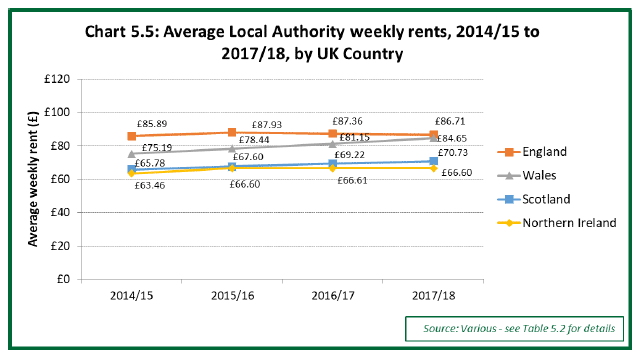
England has had the highest average local authority rents in each year between 2014/15 and 2017/18, despite average rents in England falling across the latest two years, by 0.6% and 0.7% respectively, which is likely to have been due to reduction in rents following the UK Government Summer Budget in 2015.
Wales has had the second highest average local authority rents in each year, although the gap between England and Wales has been narrowing each year due to rents rising at a faster rate in Wales over the latest three years (4.3%, 3.5% and 4.3% respectively), which is likely to have been due to the Wales rent setting policy including provisions for increases of CPI+1.5%.
Northern Ireland has seen the lowest average local authority rents in each year, and has seen change of around 0% in average rents over the last two years.
Scotland has seen average local authority rents across the 2014/15 to 2017/18 period which were slightly higher than those in Northern Ireland, with annual increases over the latest three years being 2.8%, 2.4% and 2.2% respectively. In the latest year 2017/18, average local authority rents in Scotland were around 6% higher than in Northern Ireland, around 18% lower than in England, and around 16% lower than in Wales.
5.2 Household income - banded net income
The Scottish Household Survey collects information on the annual net income of households. In 2017, 29% of social rented households had a net household income of between £10k and £15k, whilst 22% had income of between £15k and £20k.
Chart 5.6: Net income of social rented households, 1999, 2008 and 2017
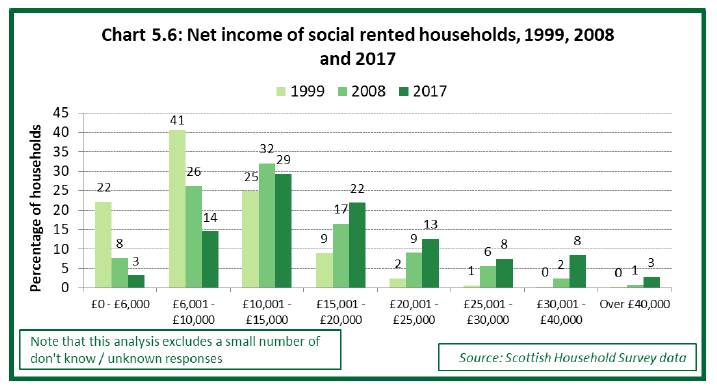
The distribution of income levels appears to have shifted upwards from 1999 to 2017. For example, in 1999 22% of social rented households had a net income of £6k or less, and this has dropped to 3% of households in 2017. Correspondingly only 3% of social rented households had a net income of more than £20k in 1999, and this has increased to 31% of households in 2017. Some of these changes may be due to general inflation levels across the time period 1999 to 2017.
There was little difference in net household income between local authority and housing association households in 2017, as shown in Chart 5.7 below.
Chart 5.7: Net income of social rented households, 2017, by social landlord
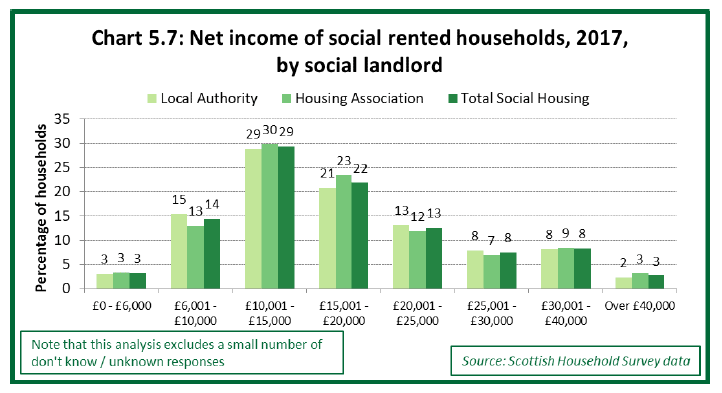
Chart 5.8 below shows the net annual income of social rented households between 2013 and 2017 for each local authority. East Renfrewshire had the highest proportion earning less than £10,000 a year (30%) whereas Shetland had the highest proportion earning over £30,000 a year (22%).
Chart 5.8: Net annual income of social rented households, 2013 to 2017, by local authority
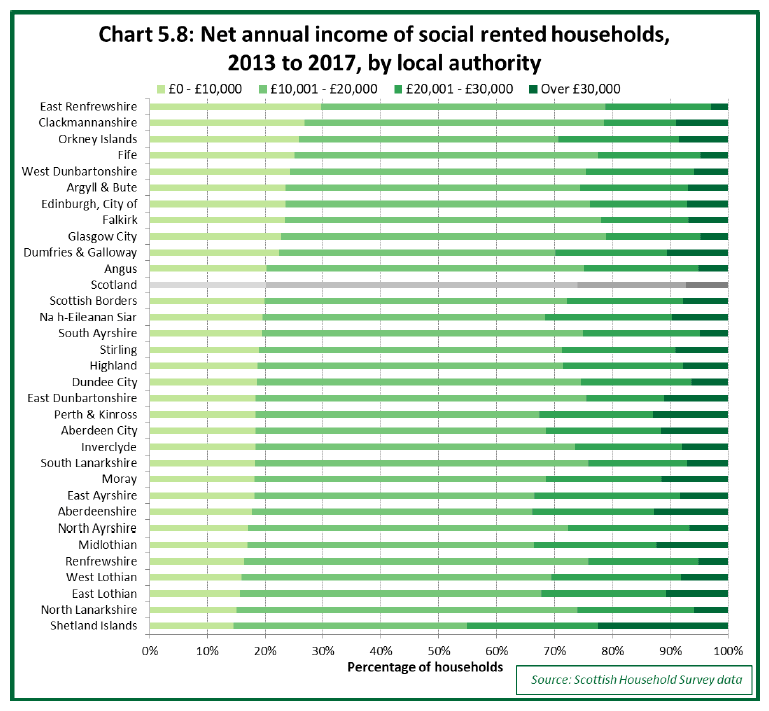
Note: survey data from the five years from 2013 to 2017 has been combined together to provide a sufficient sample size to allow a local authority level analysis. However local authority sample sizes across these four years vary from 130 in East Renfrewshire up to 1,430 in Glasgow City, and so there will be larger margins of error for some local authorities than others. As such some differences between local authorities should be treated with caution, as these might reflect sampling variation rather than real changes.
There were differences in net income levels in 2016 between different tenures. In 2017, 69% of social rented households had a net income of £20k or less, which compares to 46% of private rented households, 46% of households owned outright and 14% of households buying with a mortgage.
Chart 5.9: Net income of households, 2017, by tenure
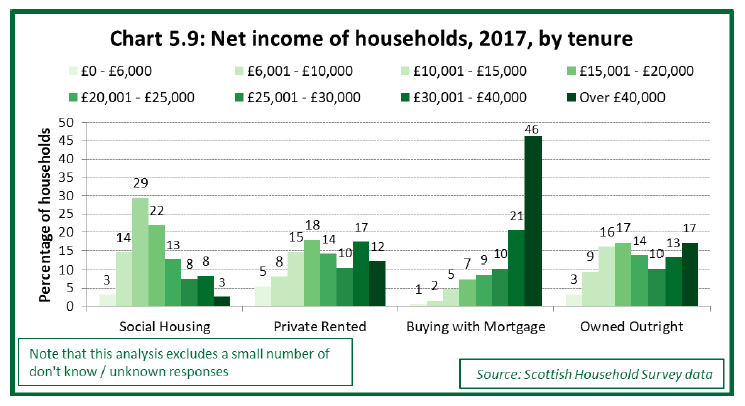
Information about household income is also collected through the Family Resources Survey[34]. Chart 5.10 below shows the net household income profiles of households by tenure over the 3-year period from 2015/16 to 2017/18, based on the Family Resources Survey. The data shows similarly shaped income distributions to the Scottish Household Survey based analysis in Chart 5.9 above.
Chart 5.10: Net income of households, by tenure, 2015/16 to 2017/18
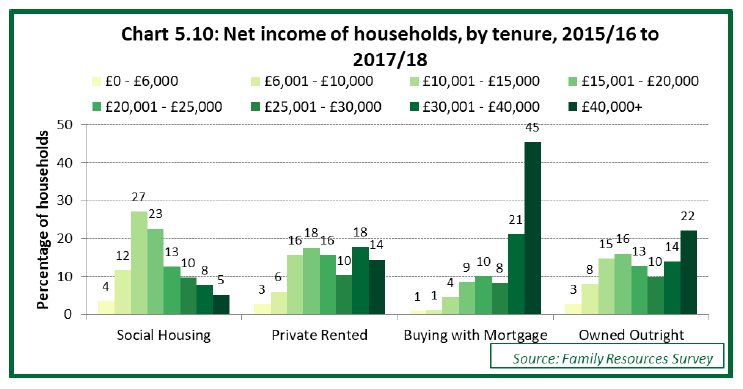
Chart 5.11 below shows the distribution of net household income for social rented households, by country. The distributions of incomes in Scotland were broadly similar to the other countries in GB, however there were some differences, for example, the percentage of social households earning less than £15k was higher in Scotland (42%) than in England (34%).
Chart 5.11: Net income of social rented households, 2015/16 to 2017/18, by country
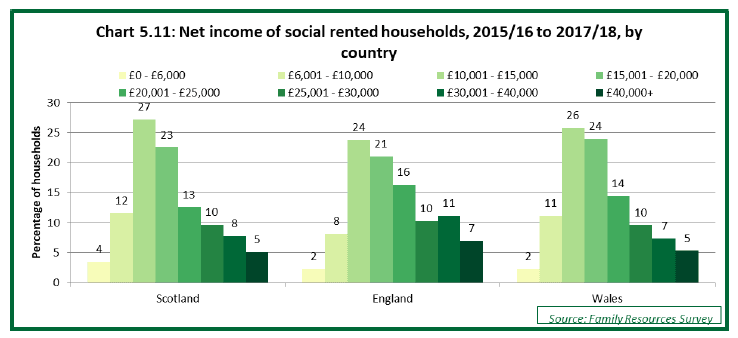
Based on the Scottish Household Survey data, looking at social rented households in Scotland in which an adult had moved into the address within the last 12 months (which includes new-lets as well as changes to existing household compositions), in the period 2013 to 2017, 30% had a net income of over £20k, a figure similar to the equivalent percentage of 31% for all social households in 2017.
Chart 5.12: Net income of social rented households where an adult has moved into the address within the last 12 months
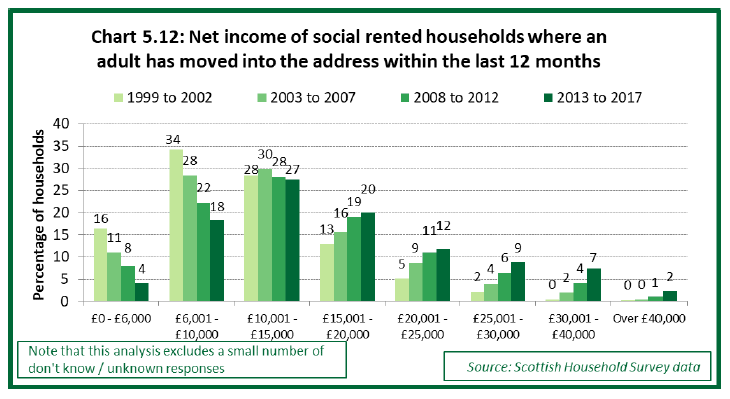
5.3 Households in the lowest income quintile
Income quintiles divide households into 5 equally sized groups to reflect their net household income. For the purposes of this analysis, household responses to the Family Resources Survey have been ranked by their net equivalised income, from lowest to highest. Equivalised income takes account of the number of people living in the household, and has been used within this section so that we can assess the likelihood of households being within the lowest quintile irrespective of differences to average household sizes by tenure. The ranked dataset has been divided into 5 equally sized groups, where households with the lowest incomes are in the first quintile, through to the households with the highest income, which are in the fifth quintile. In this section, the lowest income quintile refers to the 1 in 5 (20%) of households in each of Scotland, England, or Wales, that have the lowest net household income in each of these countries.
Chart 5.13 below shows that a greater percentage of social rented households are in the lowest income quintile. In 2015/16 to 2017/18, 34% of social rented households were in the lowest income quintile group in Scotland, which is broken down to 36% for local authorities and 32% for housing associations, and which was higher than the equivalent percentages for other tenures (22% of private rented households, 20% of households who own outright and 7% of households who own with a mortgage). The proportion of social rented households in the lowest income quintile has remained at similar levels between 2006/07 to 2008/09 (35%) to 2015/16 to 2017/18 (34%).
Chart 5.13: Percentage of households in lowest income quintile, Scotland
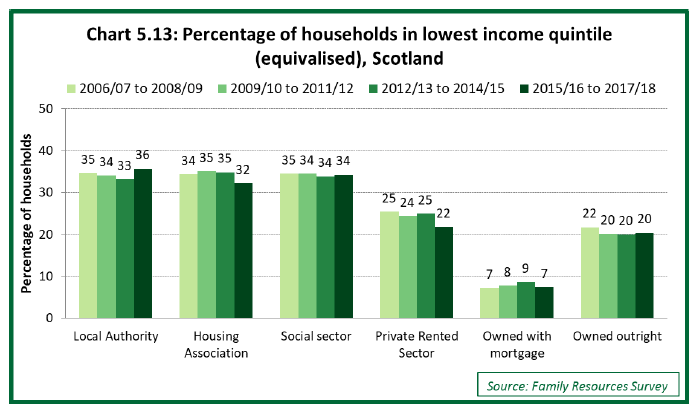
There has been a slight drop in the proportion of private rented sector households in the lowest income quintile from 25% in 2012/13 to 2014/15 to 22% in 2015/16 to 2017/18, although some caution is needed in interpreting these changes due to sampling variation.
The chart below provides a comparison of Scotland with other countries in the UK for the period 2015/16 to 2017/18. Scotland has a slightly higher proportion of rented households in the lowest income quintile, and a slightly lower proportion of owned properties in the lowest income quintile when compared to England, although again some caution is needed in interpreting these changes due to sampling variation.
Chart 5.14: Percentage of households in lowest income quintile in each country, 2015/16 to 2017/18
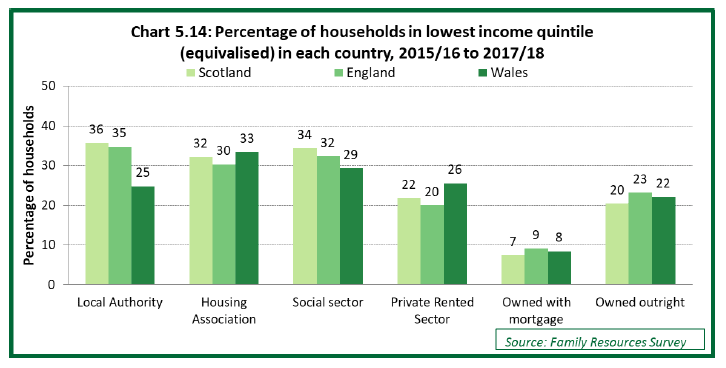
5.4 Housing costs as a proportion of income
Chart 5.15 below show the median ratio of housing costs as a proportion of net household income from 2006/07 to 2017/18 for each tenure category. This analysis is based on the 'ratio of housing costs to income' which is also used as an indicator in the Scottish Government Housing and Regeneration Outcome Indicators Framework[35], with additional analysis to split out social rented into the constituent categories of local authority and housing association households. In this analysis Housing Benefit payments are included in the net household income. Net income is the total income received by the households excluding taxes such as income tax and council tax. Net income has not been adjusted ("equivalised") for family size. Housing costs include rent gross of Housing Benefit, as well as water rates and service charges where applicable.
For the analysis presented in this report, pooled samples across years of data have been used to improve statistical reliability. Across the 3-year period from 2015/16 to 2017/18, local authority households in Scotland spent on average 24% of their net household income on housing costs, a figure similar to the equivalent percentage of 25% for housing association households. The social sector combined ratio over 2015/16 to 2017/18 was 24%. These figures compare to equivalent figures of 27% for private rented households, 8% for households owned with a mortgage and 3% for households owned outright. The similar ratio figures between social households and private rented households is likely to reflect those in the private rented sector having higher average rental costs but also having higher average income levels to those in social housing.
Housing costs as a proportion of income for those owning with a mortgage or who own outright are lower than each of the rented sectors, which may reflect either higher average household incomes or lower housing costs. In particular, households who own their properties outright have no rental or mortgage costs.
In Scotland, average ratios of housing costs to net household income have remained relatively stable over time within most tenure categories, although there has been a slight increase in the median ratio in the latest period for local authority households, and a drop in median ratio of housing costs to income in for households owned with a mortgage, from 13% in 2006/07 to 2008/09 to 8% in 2015/16 to 2017/18.
Chart 5.15: Median ratio of housing costs to net unequivalised household income, by tenure and year, Scotland
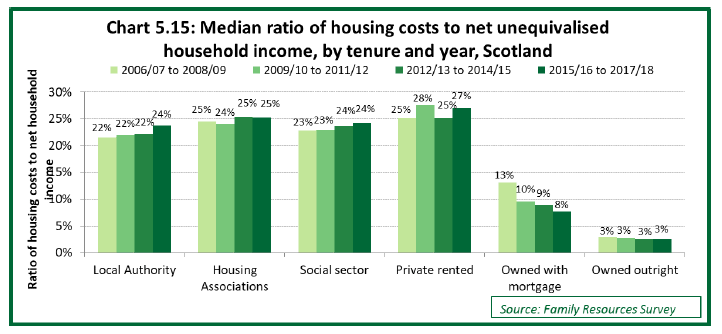
Chart 5.16 below illustrates how the average ratios of housing costs to income have differed for each GB country over the 3-year period from 2015/16 to 2017/18. Social rented households in Scotland were on average paying less on housing costs as a proportion of income (24%) than households in England (30%).
Chart 5.16: Median ratio of housing costs to net unequivalised household income, 2015/16 to 2017/18, by tenure and country
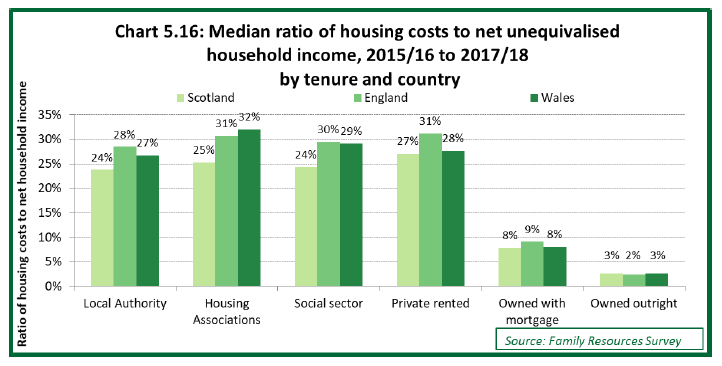
Using housing cost to income ratios, it is also possible to estimate how many households are spending more than 30% of the income on housing costs, as shown in Chart 5.17 below which covers the 3 year period from 2015/16 to 2017/18. In the social sector, 34% of households in Scotland were spending more than 30% of their net income on housing costs, lower than the 49% seen in England and 48% seen in Wales. Findings for local authority and housing associations are also presented, however caution is required when comparing countries due to smaller sample sizes. In the private rented sector, 42% of households in Scotland were spending more than 30% of their net income on housing costs, similar to the 45% in Wales, but lower than the 53% seen in England.
Chart 5.17: Percentage of households spending more than 30% of net household income on housing costs, 2015/16 to 2017/18
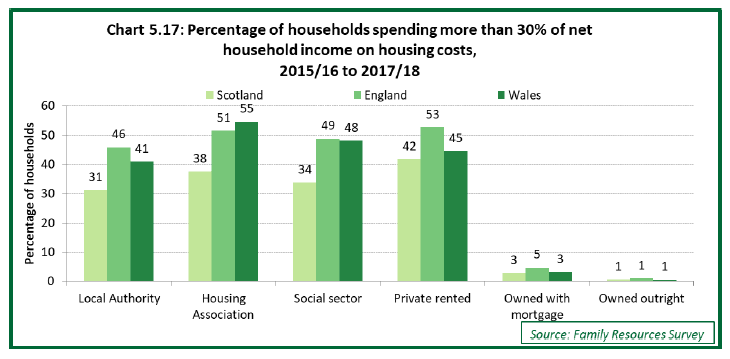
5.5 Financial support - Housing Benefit, Universal Credit Housing Entitlement, and Discretionary Housing Payments
Housing Benefit is available to support eligible low income households with the cost of renting their home. It cannot be used to pay for other costs, such as food or heating, and households that do not pay rent, for example if they are owned with the help of a mortgage, are not eligible. The award can cover the whole cost of rent or part of it, depending on income, circumstances, and other factors such as the type of landlord and local housing allowance rates.
Universal Credit is being introduced in stages across the UK, and will replace the following benefits: Child Tax Credit, Housing Benefit, Income Support, income-based Jobseeker's Allowance (JSA), income-related Employment and Support Allowance (ESA), and Working Tax Credit. Some Universal Credit claimants will receive the housing entitlement, which will provide help with rent costs.
By March 2017, the Full Universal Credit service had been rolled out in the following areas of Scotland:
- East Lothian (March 2016)
- Highland (Inverness) (June 2016)
- East Dunbartonshire (November 2016)
- Inverclyde (November 2016)
- Midlothian (March 2017)
As at March 2017 there were a total of 20,989 households on Universal Credit with a housing entitlement in Scotland, comprising of 14,560 households in the social rented sector, 6,380 households in the private rented sector, and a further 49 households where the tenure was unknown.
Chart 5.18 below shows the percentage of households receiving Housing Benefit from 2011 to 2017 for each tenure, for Scotland, England and Wales, based on data from Department of Work and Pensions (DWP), StatXplore and Ministry of Housing, Communities and Local Government (MHCLG) stock by tenure figures.
Chart 5.18: Housing Benefit claimants as a percentage of dwellings by tenure and country
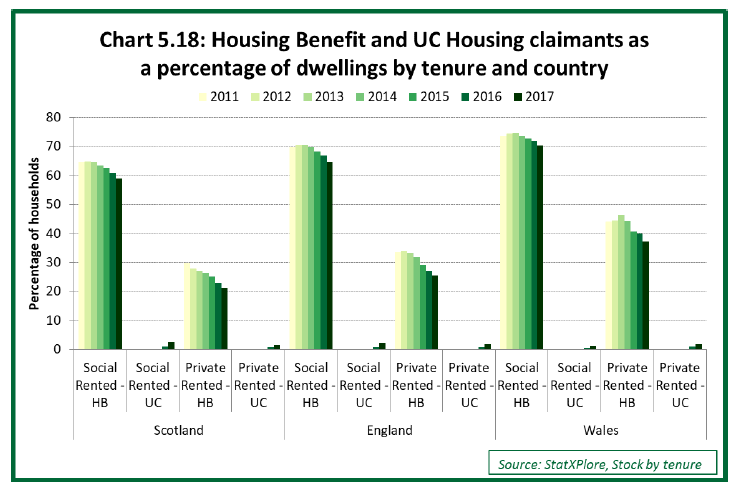
The percentage of rented dwellings in Scotland in which the household received Housing Benefit has decreased between 2011 and 2017, now standing at 59% for social rented households and 21% of private rented sector households. Although some of the decrease in the most recent two years will be due to the roll out of Universal Credit, where some households will now be receiving the Housing Entitlement for instead of Housing Benefit. Similar trends over time have been seen in both England and Wales.
The percentage of households receiving Housing Benefit in Scotland is slightly lower than England or Wales. For example, in 2017, 59% of social rented households in Scotland received Housing Benefit, compared to 65% in England and 70% in Wales. And 21% of private rented households in Scotland received Housing Benefit, compared to 26% in England and 37% in Wales.
As at March 2017, 2% of social rented households in Scotland had a Universal Credit Housing Entitlement, the same percentage as England, but slightly higher than Wales (1%). Also as at March 2017, 2% of private rented households in Scotland had a Universal Credit Housing Entitlement, the same percentage as both England and Wales.
Chart 5.19 shows the median percentage of housing costs covered by Housing Benefit, as measured by the Family Resources Survey over the period from 2015/16 to 2017/18. The average figures presented have been calculated based on the median ratio of the value of Housing Benefit received as a proportion of total housing costs for each household in the survey. Note that the calculation only includes households that are in receipt of some amount of Housing Benefit, and that households receiving Universal Credit Housing Entitlement are excluded from the analysis.
Percentages of housing costs covered by Housing Benefit can be lower than claimant rates for a number of reasons:
- If the claimant's income exceeds a pre-determined amount (the applicable amount), then the Housing Benefit award will be less than their rent.
- If the household is in the private sector, Housing Benefit amounts can be capped at the Local Housing Allowance rate.
- Housing benefit can only cover rent costs whereas housing costs can include other charges such water rates, ground rent, and service charges.
- The spare room subsidy (also known as the 'bedroom tax') can reduce Housing Benefit for households in the social sector if the household is deemed to have more bedrooms that required for the residents of the household. The bedroom tax is mitigated in Scotland through Discretionary Housing Payments.
When looking at local authority households in Scotland in receipt of Housing Benefit, the average (median ratio) value of housing costs covered by Housing Benefit was 94% (see Chart 5.19 below). This means that when looking at the ratio of Housing Benefit to housing costs for each household and then ordering these from low to high, the median (middle) value of all these ratios was 94%. The figure was the same (94%) for housing association households. For private rented households the equivalent figure was 83%.
Social rented households in Scotland had a median value of 94% of housing costs covered by Housing Benefit, a figure higher than the equivalent percentage for England (89%) The figure for Wales was also 89% however due to sample sizes there is insufficient evidence to say whether or not this is significantly different to Scotland's figure.
Housing costs can include more than just rent, and therefore for many households Housing Benefit is likely to make up a higher proportion of rent than compared to total housing costs. When looking at the ratio of Housing Benefit to rental costs for each social rented household and then ordering these from low to high, the median (middle) value of all these ratios is estimated to be 100% (i.e. more than half of social rented households are receiving Housing Benefit that covers their rent by 100%). An estimated 67% of social rented households are estimated to have their rent fully covered by Housing Benefit.
Chart 5.19: Median percentage of housing costs covered by Housing Benefit for claimants in Scotland, 2015/16 to 2017/18
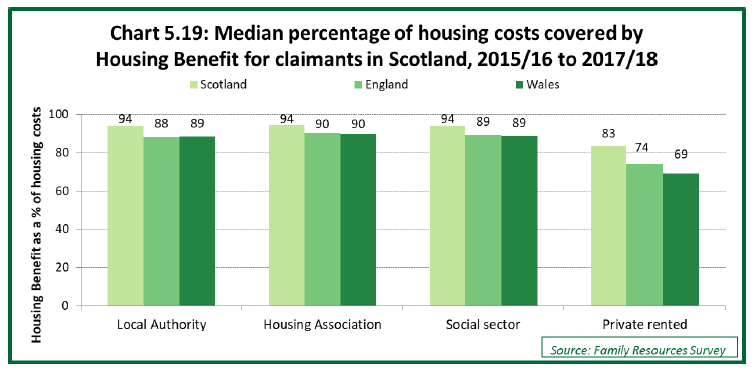
Discretionary Housing Payments (DHPs) are administered in Scotland by local authorities, and may be awarded when a local authority considers that a claimant on Housing Benefit or Universal Credit (which includes a housing element towards rental liability) requires further financial assistance towards housing costs.
The Scottish Government's total published budget for DHPs in 2017/18 was £57.9m. This includes two funding streams for DHPs, "Bedroom Tax Mitigation" (£47m) and "Other DHPs" (£10.9m).
During 2017/18, 122,660 DHP awards were granted, with an average award value of £483. This figure is likely to include a sizeable number of cases affected by the Removal of the Spare Room Subsidy, where local authorities have continued to make up their shortfall in weekly rent through the use of DHPs. The total value of awards spent across Scotland in 2017/18 was £59.2 million.
For further details see Discretionary Housing Payments in Scotland Statistics publications available at http://www.gov.scot/Topics/Statistics/Browse/Social-Welfare/dhp.
5.6 How well households are managing financially
The Scottish Household Survey asks respondents how well their household is managing financially. In the latest year (2017), 30% of social rented households stated that they managed well, an increase from 21% in 1999.
Chart 5.20: How well social households are managing financially, 1999, 2008 and 2017
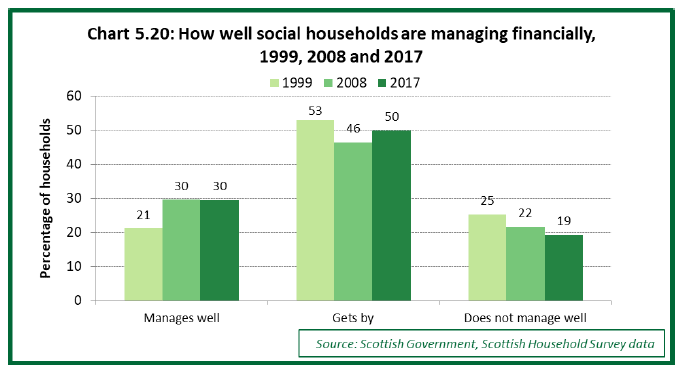
There is little difference in responses between local authority and housing association households in 2017, with similar percentages being reported for each category.
Chart 5.21: How well social households are managing financially, 2017, by social landlord
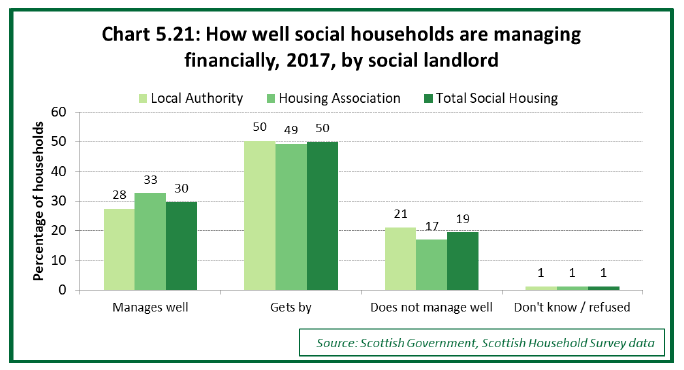
Chart 5.22 below shows how well social rented households are managing financially between 2013 and 2017 for each local authority. Na h-Eileanan Siar (41%) and Orkney (40%) had the highest proportion reporting they are managing well, whereas Perth & Kinross (21%) and Glasgow (23%) had the lowest proportions reporting they were managing well financially.
Chart 5.22: How well social households are managing financially, 2013 to 2016, by local authority
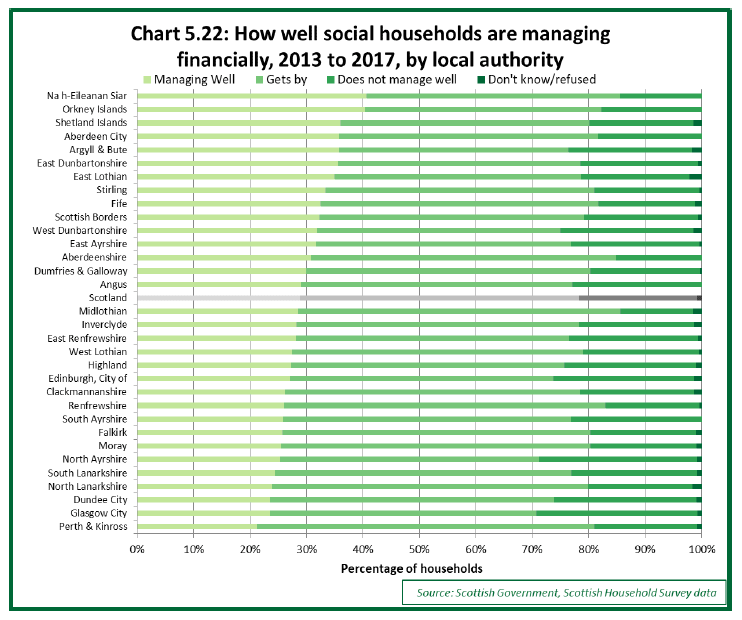
Note: survey data from the five years from 2013 to 2017 has been combined together to provide a sufficient sample size to allow a local authority level analysis. However local authority sample sizes across these four years vary from 140 in East Renfrewshire up to 1,670 in Glasgow City, and so there will be larger margins of error for some local authorities than others. As such some differences between local authorities should be treated with caution, as these might reflect sampling variation rather than real changes.
Chart 5.23 below shows how social households compare to other tenures for how well they are managing financially in 2017. Social households are less likely to be managing well (30%) compared with private rented households (41%), households buying with a mortgage (64%) and households who own outright (73%). Correspondingly social households are more likely to not be managing well (19%) compared with other tenures (12% for private rented households, 5% for households buying with a mortgage and 2% for households who own outright).
Chart 5.23: How well households are managing financially, 2017, by tenure
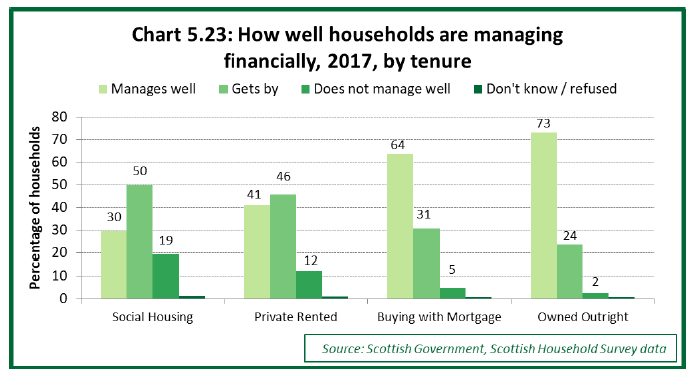
When looking at social rented households in Scotland in which an adult had moved into the address within the last 12 months (which includes new-lets as well as changes to existing household compositions), 24% stated they managed well in 2013 to 2017, a figure lower than the equivalent percentage (30%) for all social households in 2017. Whilst 26% stated they did not manage well in 2013 to 2017, a figure higher than the equivalent percentage (19%) for all social households in 2017. This suggests that newly formed social rented households are less likely to be managing well financially than more established social rented households.
Chart 5.24: Financial management of social rented households, where an adult has moved into the address within the last 12 months
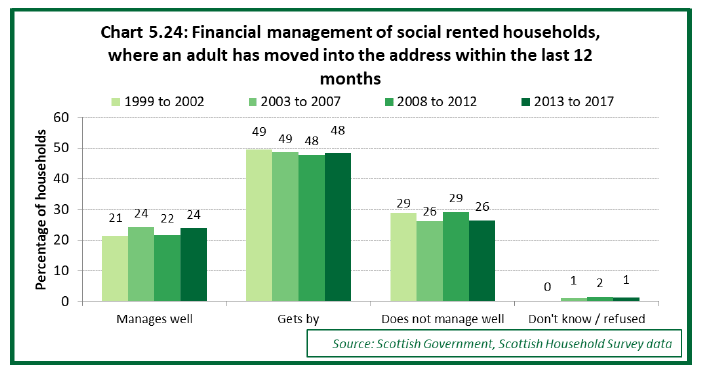
Contact
There is a problem
Thanks for your feedback